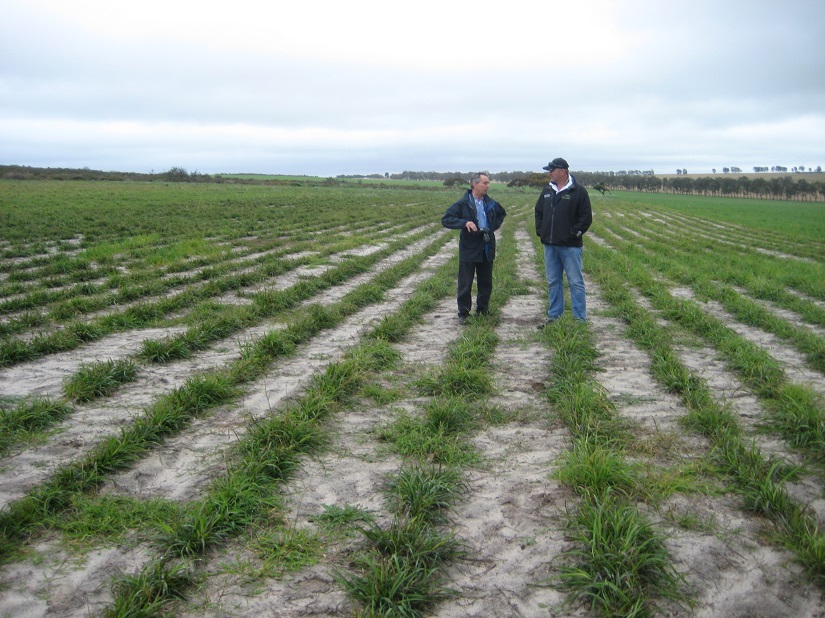
The wet 2021 season provides an opportunity for landholders with bare sandy paddocks to plant pastures and grasses to protect their soils from wind erosion in coming months.
Despite widespread rainfall, there are still areas of the Grainbelt, particularly pasture paddocks in the Midwest and the West Midlands, that have insufficient ground cover to prevent wind erosion – particularly over the warmer months.
Department of Primary Industries and Regional Development (DPIRD) research scientist Geoff Moore said with plenty of subsoil moisture available, spring seeding pastures provided a possible solution to reduce the risk of wind erosion.
Mr Moore said there were three short-term options to implement in coming weeks to provide ground cover on sandy soils, with the possibility of providing an additional stockfeed option a bonus – providing there is surplus biomass.
“Up until mid-September, there is a small window to sow a mixture of temperate, or C3, annual grasses, like cereal rye, Shirohie millet and feed barley,” he said.
“After mid-September the preferred option is to sow warm season, or C4, annual grasses, such as hybrid sorghum, Sudan grass and pearl millet, which require warmer soil temperatures to germinate and will grow rapidly if there is summer rain.
“It is important for livestock producers to note that hybrid sorghum has a risk of prussic acid poisoning so if planning to graze it would be safer to sow pearl millet or Sudan grass.
“The third option from mid-August through to early September is to sow subtropical warm season grasses.”
The department recommends landholders aim to have at least 50 per cent of groundcover, of which about 30 per cent should be anchored, by the beginning of autumn to prevent wind erosion through to autumn 2022.
DPIRD’s Season 2021 webpages have more land management information, including several useful articles to assist growers with managing wind erosion.
Stubble retention of a bumper grains crop will be crucial to mitigate the risk of wind erosion blowing away next year’s crop potential, as will careful management when grazing stubbles and dry pasture.
Soil and Land Conservation Commissioner Cec McConnell said preventing wind erosion to optimise soil productivity next season started now.
“The 2021 season provides an opportunity to optimise ground cover and prevent a repeat of large-scale wind erosion events in late summer and autumn seen in previous years,” she said.
“Good planning and land management practices over the coming months will be an investment in the productive potential and sustainability of our soil resource.”
More information on spring sowing opportunities, as well as pests and disease management and other information to navigate the season ahead can be found on DPIRD’s Season 2021 webpages at agric.wa.gov.au
The wet 2021 season provides an opportunity for landholders with bare sandy paddocks to plant pastures and grasses to protect their soils from wind erosion in coming months.
Despite widespread rainfall, there are still areas of the Grainbelt, particularly pasture paddocks in the Midwest and the West Midlands, that have insufficient ground cover to prevent wind erosion – particularly over the warmer months.
Department of Primary Industries and Regional Development (DPIRD) research scientist Geoff Moore said with plenty of subsoil moisture available, spring seeding pastures provided a possible solution to reduce the risk of wind erosion.
Mr Moore said there were three short-term options to implement in coming weeks to provide ground cover on sandy soils, with the possibility of providing an additional stockfeed option a bonus – providing there is surplus biomass.
“Up until mid-September, there is a small window to sow a mixture of temperate, or C3, annual grasses, like cereal rye, Shirohie millet and feed barley,” he said.
“After mid-September the preferred option is to sow warm season, or C4, annual grasses, such as hybrid sorghum, Sudan grass and pearl millet, which require warmer soil temperatures to germinate and will grow rapidly if there is summer rain.
“It is important for livestock producers to note that hybrid sorghum has a risk of prussic acid poisoning so if planning to graze it would be safer to sow pearl millet or Sudan grass.
“The third option from mid-August through to early September is to sow subtropical warm season grasses.”
The department recommends landholders aim to have at least 50 per cent of groundcover, of which about 30 per cent should be anchored, by the beginning of autumn to prevent wind erosion through to autumn 2022.
DPIRD’s Season 2021 webpages have more land management information, including several useful articles to assist growers with managing wind erosion.
Stubble retention of a bumper grains crop will be crucial to mitigate the risk of wind erosion blowing away next year’s crop potential, as will careful management when grazing stubbles and dry pasture.
Soil and Land Conservation Commissioner Cec McConnell said preventing wind erosion to optimise soil productivity next season started now.
“The 2021 season provides an opportunity to optimise ground cover and prevent a repeat of large-scale wind erosion events in late summer and autumn seen in previous years,” she said.
“Good planning and land management practices over the coming months will be an investment in the productive potential and sustainability of our soil resource.”
More information on spring sowing opportunities, as well as pests and disease management and other information to navigate the season ahead can be found on DPIRD’s Season 2021 webpages at agric.wa.gov.au
Caption: PIRD research scientist Geoff Moore (left), talking to agronomist Owen Mann at a field day at Walkaway, says there is an opportunity to sow pastures and grasses in the next few weeks to mitigate the risk of wind erosion on bare paddocks.


